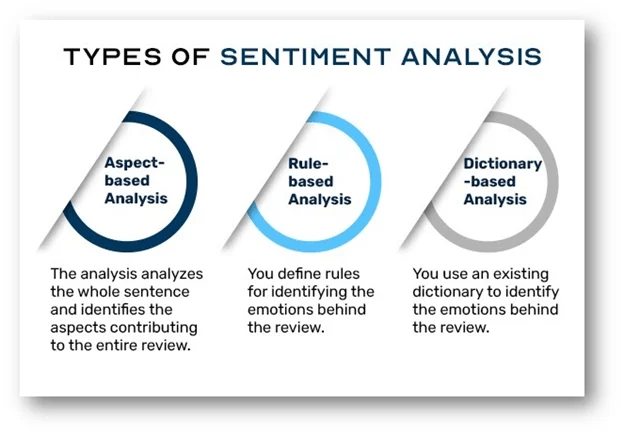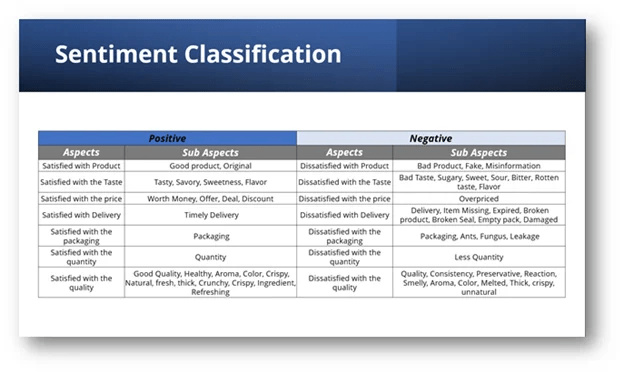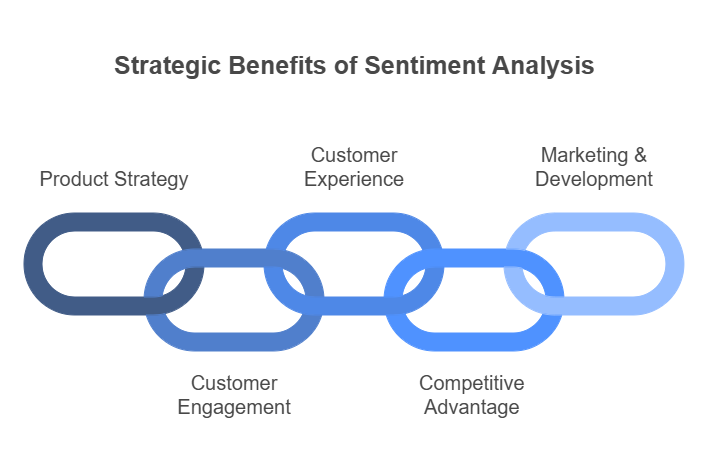The eCommerce landscape has evolved significantly, but one constant remains—sentiment analysis, customer reviews, and ratings play a crucial role in purchasing decisions.
A recent report by Zendesk found that 88% of customers who read an online review say it influenced their buying decision. Furthermore, 76% of shoppers say they are more likely to purchase from a brand with predominantly positive reviews.
Wouldn’t it be invaluable to understand what your customers think about your products? If you could interpret their sentiments and leverage them to enhance their experience?
That’s where sentiment analysis comes into play. This AI-powered technique uses Natural Language Processing (NLP) and machine learning to analyze customer feedback, helping brands highlight concerns and enhance their offerings proactively.
Moving forward, we’ll dive into how sentiment analysis works, its benefits for eCommerce, and how it integrates with digital shelf analytics to drive business growth.
Sentiment analysis can be branched out into these categories: rule-based analysis, dictionary-based analysis, and aspect-based analysis. Here’s a detailed comparison of the three approaches, along with their limitations:

Table of Contents
Rule-Based Analysis
Predefined rules or patterns are used to classify sentiment based on specific words or expressions. Based on a logical framework, it is an offshoot of NLP, in which the system tries to deduce the sentiment expressed, as in the example above, from a set of rules that have been programmed into it.
- Strengths:
- Easy to implement and interpret.
- No need for extensive data or training.
- Transparent results, as rules can be manually reviewed.
- Limitations:
- Struggles with nuanced language (e.g., sarcasm or irony).
- Requires continuous refinement as language evolves.
- Limited scalability for large datasets.
- Fixed rules can miss contextual, subtle ties or complex sentences.
Dictionary-Based Analysis
Sentiment dictionaries assign scores to words (positive, negative, neutral) to evaluate sentiment. It uses a dictionary or a set of predefined words and phrases that have been pre-classified either positively or negatively. This list can be created manually or derived algorithmically with the help of machine learning algorithms.
- Strengths:
- Works well with simple text and predefined sentiment lexicons.
- Easy to use with minimal customization.
- Suitable for quick, general analysis.
- Limitations:
- Requires domain-specific lexicons for accuracy.
- Struggles with negations (e.g., “not good”), slang, and evolving terminology.
- Doesn’t account for multi-word expressions or subtle contextual changes.
- Sentiment scoring may lack precision in complex sentences.
Aspect-Based Analysis
Sentiment is analyzed for specific aspects or features (e.g., “quality,” “price”) within the text. It focuses on extracting opinions, feelings, and emotions associated with each aspect rather than trying to analyze the complete polarity of the content.
- Strengths:
- Provides detailed insights by focusing on specific features.
- Highly actionable for improving particular areas of customer experience.
- Helps with domain-specific analysis, linking feedback to tangible improvements.
- Limitations:
- Requires sophisticated techniques (e.g., NLP or machine learning) for aspect extraction.
- Can be challenging for large datasets.
- May require labeled training data or models to associate aspects with sentiment.
- It gets difficult to handle text without clear aspect mentions or implicit sentiments.
Each of these approaches has unique applications depending on the context, data, and goals. For instance:
- Rule-Based is great for quick fixes or straightforward classification.
- Dictionary-Based works for general sentiment but lacks depth.
- Aspect-Based is ideal for actionable insights but needs more resources.
The aspects machine learning can identify through NLP

The image depicts how sentiments are classified and how they help identify positive and negative aspects and sub-aspects of the review
- Delivery
- Price
- Product
- Packaging
- Performance
- Quality
- Services
- Taste
Now that we’ve covered the fundamentals and workings of sentiment analysis, let’s dig deeper into understanding sentiment analysis in the eCommerce space.
Understanding Sentiment Analysis from an eCommerce Perspective

For eCommerce brands, sentiment analysis isn’t just about tracking customer opinions; it’s about interpreting those opinions in ways that directly affect business outcomes.
From an eCommerce perspective, sentiment analysis refers to the use of artificial intelligence (AI) and natural language processing (NLP) to analyze and quantify the emotions behind customer reviews, ratings, and feedback. It offers brands a deeper insight into customer satisfaction, loyalty, and overall perception—critical elements when competing in an online marketplace.
Here’s why understanding sentiment analysis is especially important for eCommerce businesses:
- Shaping Product Strategy: By analyzing customer reviews, ratings, and comments across different platforms, e-commerce brands gain a comprehensive understanding of which aspects of their products resonate with customers and which ones fall short. This insight allows businesses to make data-driven decisions for product improvements or even product development, ensuring that their offerings align with consumer expectations.
- Enhancing Customer Engagement: Sentiment analysis enables brands to identify the tone behind customer feedback. Whether it’s positive or negative sentiment, the ability to segment and analyze emotions can help businesses tailor their communication and engagement strategies. Brands can respond more effectively to negative sentiment (e.g., customer complaints) and capitalize on positive sentiment by creating personalized experiences, targeted offers, or promotional campaigns.
- Optimizing Customer Experience Across Channels: eCommerce customers interact with brands at various touchpoints—product pages, social media, customer service interactions, and more. Sentiment analysis allows brands to monitor and analyze customer sentiment across all these channels, ensuring a consistent and seamless experience. By addressing pain points, offering improvements based on sentiment feedback, and creating a responsive customer service strategy, brands can elevate their overall customer experience.
- Competitive Advantage: One of the biggest advantages of sentiment analysis for eCommerce businesses is competitor benchmarking. By analyzing the sentiment behind reviews and feedback not only for your own products but also for your competitors’ offerings, you can identify gaps in your market. This data-driven insight helps eCommerce brands stay one step ahead by adapting quickly to consumer needs, improving their positioning, and capitalizing on market opportunities.
- Driving Marketing and Product Development: For eCommerce brands, sentiment analysis provides the intelligence needed to fine-tune marketing strategies and product launches. Whether it’s understanding the emotional tone behind customer feedback or predicting future market trends, sentiment analysis empowers brands to take action. By leveraging customer sentiment insights, eCommerce businesses can make informed decisions that help shape more effective marketing campaigns, product offerings, and even pricing strategies.
Enhancing Customer Experience ft. Sentiment Analysis
Uncover Customer Insights in Real-Time
Today’s digital shoppers rely heavily on customer reviews before making purchases. According to PowerReviews, 99.9% of customers read reviews when shopping online, with 62% filtering products by those rated four stars or higher.
By implementing sentiment analysis, brands can:
- Identify common themes in reviews (e.g., durability, price fairness, product authenticity)
- Understand what aspects drive positive or negative perceptions
- Benchmark against competitors to refine their product positioning
Address Customer Frustrations Proactively
Negative reviews often stem from preventable issues—missing product details, misleading images, or incorrect specifications. With Digital Shelf Analytics, brands can monitor and resolve such issues before they escalate, reducing customer dissatisfaction and product returns.
Decode Sentiments Behind Ratings
Many shoppers leave ratings without detailed reviews, making it challenging to understand their reasoning. Sentiment analysis can bridge this gap by analyzing associated keywords and phrases in brief feedback. This allows brands to:
- Identify problem areas faster
- Improve product descriptions, images, and FAQs
- Enhance post-purchase experiences
Personalize Marketing Strategies
Sentiment analysis helps segment customers based on their feedback, enabling hyper-personalized marketing. For example, if customers complain about pricing, brands can create targeted discount campaigns to address concerns and improve conversion rates.
Competitive Intelligence & Market Trends
By analyzing customer sentiment across various platforms, brands can track emerging trends and industry benchmarks. For instance, if competitors receive consistent praise for sustainable packaging while your brand faces complaints about excess plastic, it’s a clear opportunity to enhance your offering.
Paxcom’s Digital Shelf Analytics tool collates reviews across platforms at a single entity for easy access. It further summarizes the positive and negative trends along with a steep comparison with the competitors’ product reviews. At Paxcom, we understand the sensitivity of maintaining online reputation and utmost customer satisfaction.
Predict Product Success Before Launch
Launching a new product is always a gamble, but sentiment analysis can predict its success by analyzing past customer feedback. By identifying key drivers of satisfaction or dissatisfaction from previous product launches, brands can refine marketing strategies and preemptively address potential pain points.
Optimize Response Time for Better Customer Engagement
A study by HubSpot found that 82% of consumers expect a response within 10 minutes of reaching out to a brand on social media. Sentiment analysis can prioritize urgent complaints, streamline customer support responses, and improve retention rates.
Improve Delivery & Shipping Services
According to a Retail TouchPoints survey, 56% of online shoppers expect same-day delivery, while 69% demand real-time tracking updates. Sentiment analysis can highlight patterns in shipping-related complaints, helping brands optimize logistics and enhance post-purchase experiences.
Identify & Leverage Shopping Trends
Understanding seasonal sentiment trends can help brands tailor inventory, pricing, and marketing strategies. For example, an increase in complaints about stockouts before major sales events like Prime Day or Black Friday suggests the need for better inventory forecasting.
Strengthen Brand Reputation Management
Your brand’s reputation isn’t just about the number of reviews—it’s about what those reviews say. Sentiment analysis allows you to:
- Measure brand perception over time
- Detect early warning signs of potential PR crises
- Address negative trends before they impact sales
How Paxcom’s Digital Shelf Analytics Empowers Brands Across the Board?
At Paxcom, we understand that excelling in eCommerce isn’t just about having a great product—it’s about monitoring every digital shelf touchpoint. That’s where Kinator, our robust Digital Shelf Analytics (DSA) platform, comes in.
Here’s how Kinator enables end-to-end performance optimization for brands:
- Price & Promo
Ensure you’re always competitively priced and in sync with live promotional trends. Kinator helps track pricing consistency across platforms and uncovers gaps in promotional execution to protect brand equity and boost conversions. - SKU Availability & Visibility
Never miss a sales opportunity. Kinator monitors out-of-stock situations and detects visibility issues across channels, enabling faster corrective actions to maximize product discoverability and availability. - Content Scorecard
From product titles and bullet points to images and A+ content, Kinator evaluates content completeness and quality across listings. Brands can benchmark against content best practices to drive higher engagement and conversion rates. - Performance Metrics
With insights on ratings, reviews, and other key KPIs, Kinator provides a 360° view of product health and customer sentiment, allowing brands to identify high-performing SKUs and optimize underperforming ones. - Category Visibility Tracking
Are your products ranking where they should be? Kinator tracks your share of digital shelf within category pages, ensuring your brand is not just present, but prominent. - Sentiment Analysis
Go beyond star ratings—Kinator’s AI-powered sentiment engine decodes the “why” behind customer feedback. From pinpointing packaging issues to identifying unmet expectations, brands get actionable insights to improve the shopper experience. - Price Variation
Sudden fluctuations in pricing across regions or marketplaces can hurt consumer trust. Kinator flags such discrepancies, helping brands maintain pricing discipline and compliance across retail partners.
Whether you’re launching a new product or scaling an established brand, customer reviews have the power to shape your reputation. The volume and sentiment of those reviews directly influence consumer trust—and in the fast-moving world of eCommerce, perception is everything.
Paxcom’s Digital Shelf Analytics tool empowers you to take control of your brand narrative. From identifying inconsistencies to enhancing product discoverability across platforms, it delivers the insights you need to turn challenges into opportunities.
Get in touch at info@paxcom.net and discover how your brand can turn insights into action.















